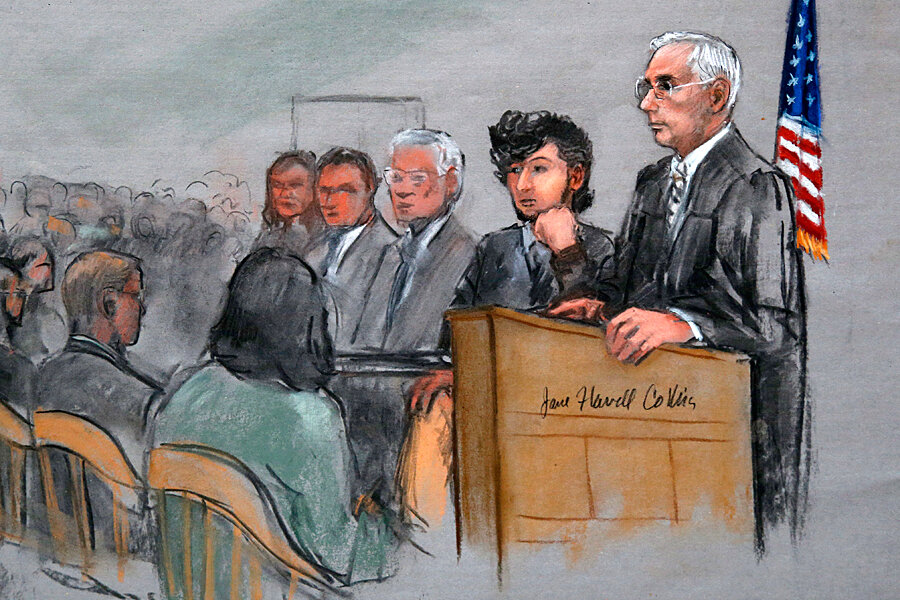The view from the courthouse in the Dzokhar Tsarnaev trial
Loading...
| Boston
The initial phase of jury selection in the trial of accused Boston Marathon bomber Dzhokhar Tsarnaev concluded Wednesday afternoon.
Three days of court hearings that saw 1,200 Massachusetts citizens descend on the US district courthouse in South Boston ended today with the last group of 200 potential jurors receiving preliminary instructions from Judge George O’Toole.
Security has been tight, with US Marshals at the entrance and a Coast Guard boat — complete with a mounted machine gun on the prow — patrolling the harbor on the other side of the courthouse.
The case is roundly considered the most high-profile death penalty case in US history since the trial of Timothy McVeigh for the 1995 Oklahoma City bombing.
The 1,200 potential jurors have been brought into the court in six groups of 200 throughout the week. Mr. Tsarnaev attended all six hearings. Tsarnaev has been seen only rarely since the bombings on April 15, 2013 — which he is accused of planning and perpetrating with his older brother, Tamerlan, who was killed in a shootout with police. A Dec. 18 status hearing in the case was his first appearance in court in almost 18 months, and his presence — and behavior — has been a focus of commentary in the trial’s first week.
Each hearing presented the scene of him at a table, flanked by his lawyers, facing hundreds of potential jurors. Yesterday, a delay in Judge O’Toole’s appearance in the room resulted in an awkward 10-minute period with Tsarnaev sitting silently in front of the crowd.
Tsarnaev appeared fidgety during the first few hearings — scratching at his face and fiddling with his hands — but seemed to grow more comfortable throughout the week. By the final hearing Wednesday afternoon, he sat calmly in his chair, either staring at his feet or at O’Toole.
O’Toole began each hearing by describing the traditional duty of jurors, before moving on to the specific procedures for the Tsarnaev case. Finally, he introduced the members of each legal team to the 200 jurors, and also ordered them to avoid all media coverage of the case until they’ve been dismissed as a potential juror.
A trial by jury, O’Toole told the potential jurors, is “one of the most fundamental principles at the core of our system of justice.”
“We need your help,” he told the final group of 200 this afternoon, “and we need your honest performance of this important duty of citizenship.”
Each juror filled out a lengthy questionnaire — a process that took hours for some – which will be used to winnow the pool down to a few hundred.
Beginning next week, the remaining potential jurors will be interviewed one-on-one by Judge O’Toole, in the presence of the prosecution and defense lawyers.
The trial is expected to start, with a 12-person jury and six alternates, on Jan. 26, and take three to four months. If the jury finds Tsarnaev guilty, it will then be asked to decide if he should be sentenced to death, or to life in prison.
Mr. Tsarnaev is charged with planning and executing a double bombing near the finish line of the Marathon on April 15, 2013. The attacks killed three people and injured more than 260. Tsarnaev is also charged with the murder of an MIT police officer in the days after the bombings.
The sidewalk outside the courthouse has been mostly empty of protesters this week – a contrast from the Dec. 18 hearing, when self-described Tsarnaev supporters briefly got into an argument with a man who was wounded in the bombing.
Tsarnaev’s defense team has entered a motion to bar any supporters from protesting outside the courthouse, saying that they espouse “outrageous conspiracy theories” — including claims that the government was responsible for the bombing and that the injuries were faked — and that their behavior could pose a “grave threat” to their client’s right to a fair trial.
On Wednesday morning, there was only one demonstrator. Kevin O’Connell, of Roslindale, Mass., said he was there to protest the FBI’s handling of its investigation into Tsarnaev’s brother, Tamerlan.
The FBI has acknowledged that Tamerlan Tsarnaev — who is suspected of carrying out the bombings with Dzhokhar — visited the Dagestan region of Russia in 2010, where authorities suspect he became radicalized. The FBI interviewed Tamerlan Tsarnaev in 2011 but declared that he wasn't an imminent threat.
“I’m not a [Tsarnaev] supporter,” O’Connell said, in an interview with the Monitor, “but I don’t think anyone should prevent them from doing that [protesting]. It’s America.”






